Knowledge base
1000 FAQs, 500 tutorials and explanatory videos. Here, there are only solutions!
This guide details the elements necessary for optimal streaming of your streams on the Streaming vidéo service.
Recommended bitrate according to video quality
When encoding your streams, it is essential to adapt the bitrate to the desired quality:
- Video SD (480p): minimum 1000 kbit/s.
- Video HD (720p): between 2500 and 4000 kbit/s.
- Video Full HD (1080p): between 5000 and 8000 kbit/s.
- Video 4K Ultra HD (2160p): starting at 15000 kbit/s.
Ensure sufficient Internet bandwidth
To ensure uninterrupted broadcasting, it is recommended to have an Internet speed at least twice the bitrate of your encoded stream, for example:
- For a Full HD stream encoded at 6000 kbit/s, a minimum internet speed of 12 Mbit/s is required.
- This margin prevents interruptions caused by connection fluctuations or other devices using the same network.
Use multi-bitrate for maximum adaptability
The multi-bitrate allows your stream to be available in several qualities, adapted to the viewers' connections. This ensures:
- A smooth experience for those with limited bandwidth.
- Optimal quality for viewers with a fast connection.
Optimize your streams for mobile users
Mobile viewers may encounter fluctuating network conditions. To improve their experience:
- Encoding at a maximum bitrate of 1000 kbit/s per stream for lower resolutions.
- Implement multi-bitrate to automatically adjust the quality.
Best practices for successful encoding and streaming
- Test your Internet connection before each broadcast.
- Prioritize a reliable encoder and update its settings according to the recommendations above.
- Make sure your network is dedicated to streaming to avoid disruptions caused by other uses.
- Plan for a backup solution (such as a 4G/5G modem) in case of connection issues.
This guide explains how to transfer an Infomaniak product from one Organization to another.
Preamble
- You can move almost all products subscribed with Infomaniak to a different Infomaniak Manager interface than the one on which the product is currently located; this is therefore an internal transfer.
- If your user has access to multiple Organizations it is even easier to send to one of them the product of your choice.
- This operation does not cause any interruption.
- The users currently having access to the selected products will not be transferred (and therefore may no longer have access to the products).
- The invoices of the selected products will not be transferred.
- my kSuite cannot be transferred.
Generate a transfer link
Prerequisites
- Be Administrator or Legal Representative within the Organization.
To transfer a product:
- Click here to access the product transfer management on the Infomaniak Manager (need help?).
- Click on the Transfer products button:
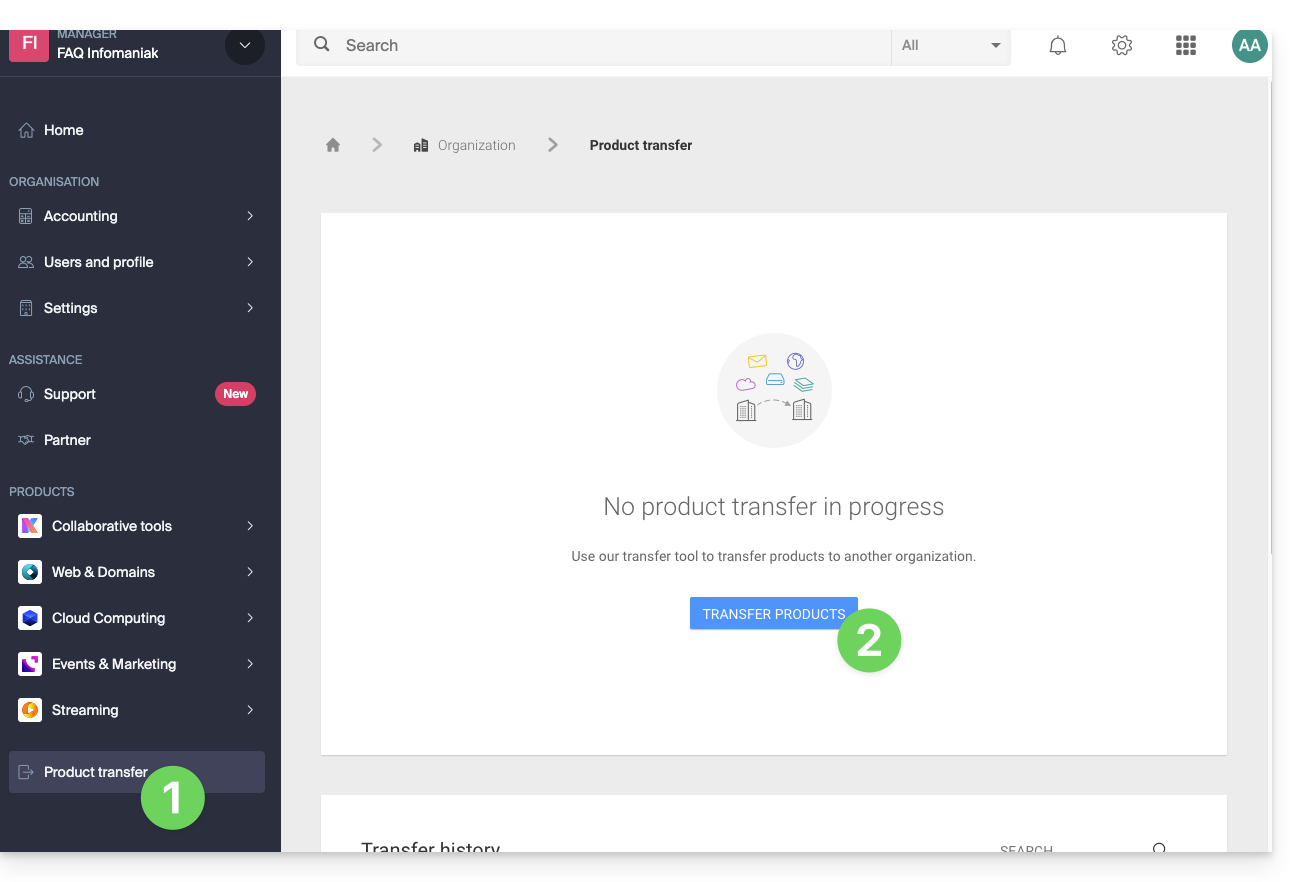
- Check the product(s) to be moved:

- Read and accept the general conditions.
- Click on the Transfer button:

- Read and validate any warnings:
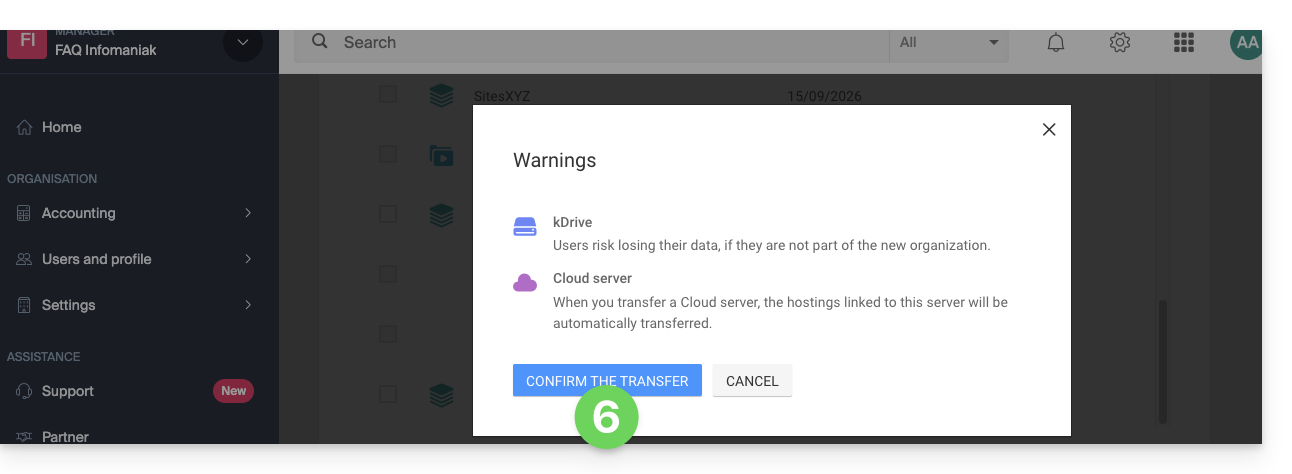
The transfer has started. Now, at your choice, you can:
- Copy the transfer link…
- or send it to the email address of your choice…
- or select directly one of the Organizations to which your user is attached, and the selected product will be transferred there:
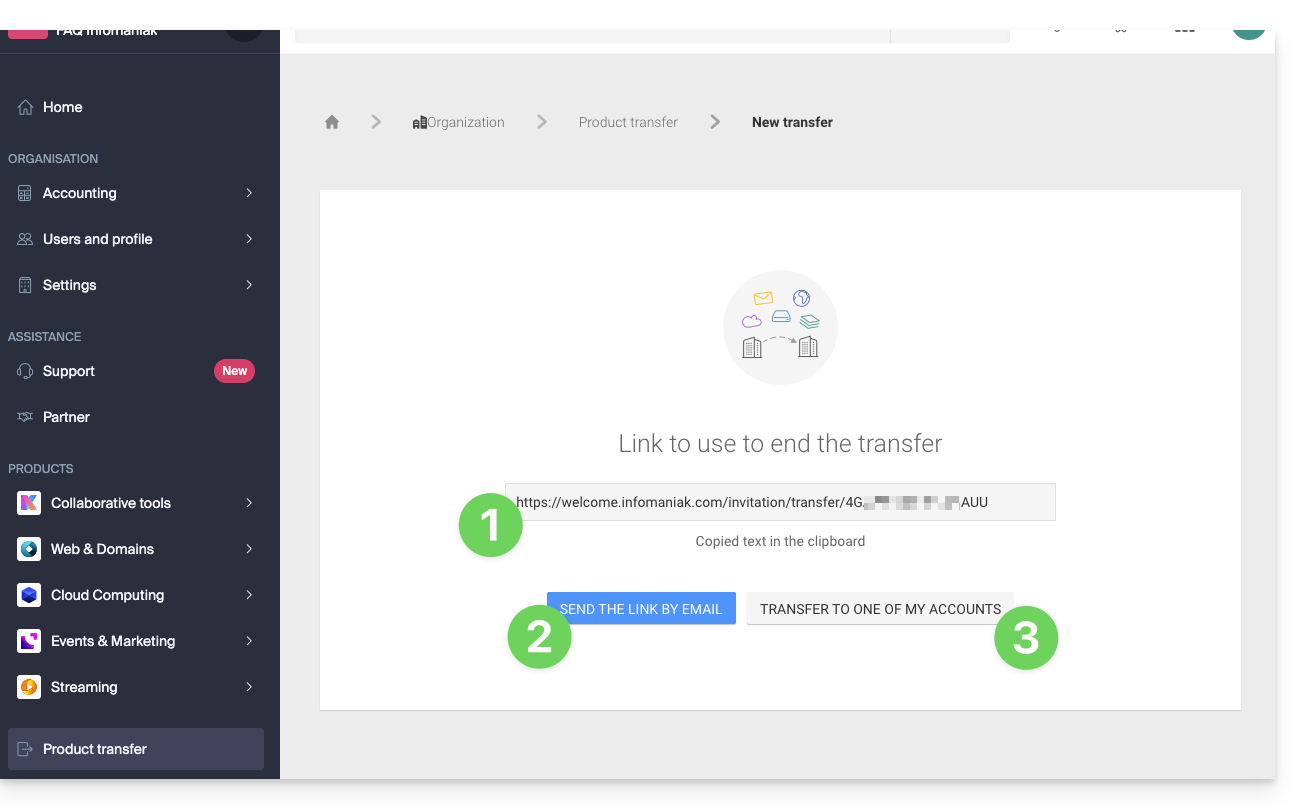
At any time, you can return to the product transfer page to find the possibilities listed above:
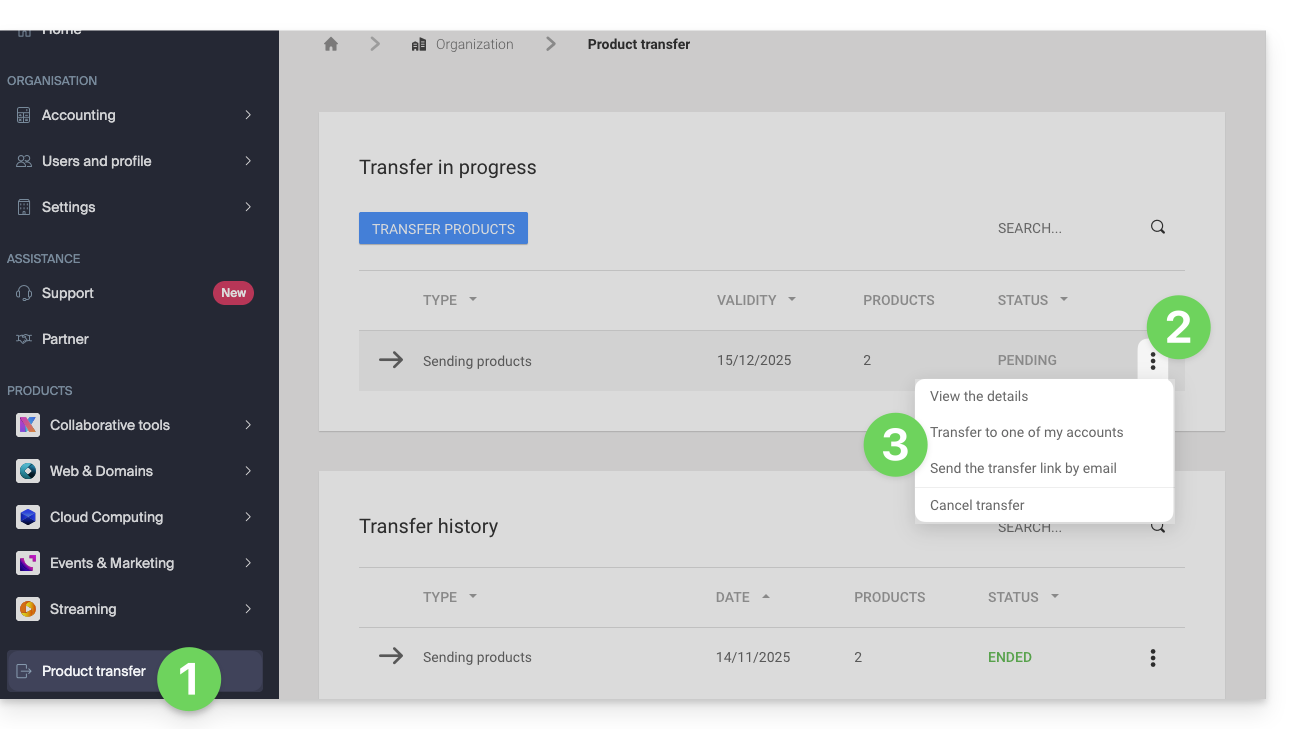
Alternative method
In the case of one-time transfer, you can also go directly to the dashboard of the product concerned and click on Manage (example in the image below) however, since this menu is not always present, it is better to prioritize the first method above, which also allows bulk transfer: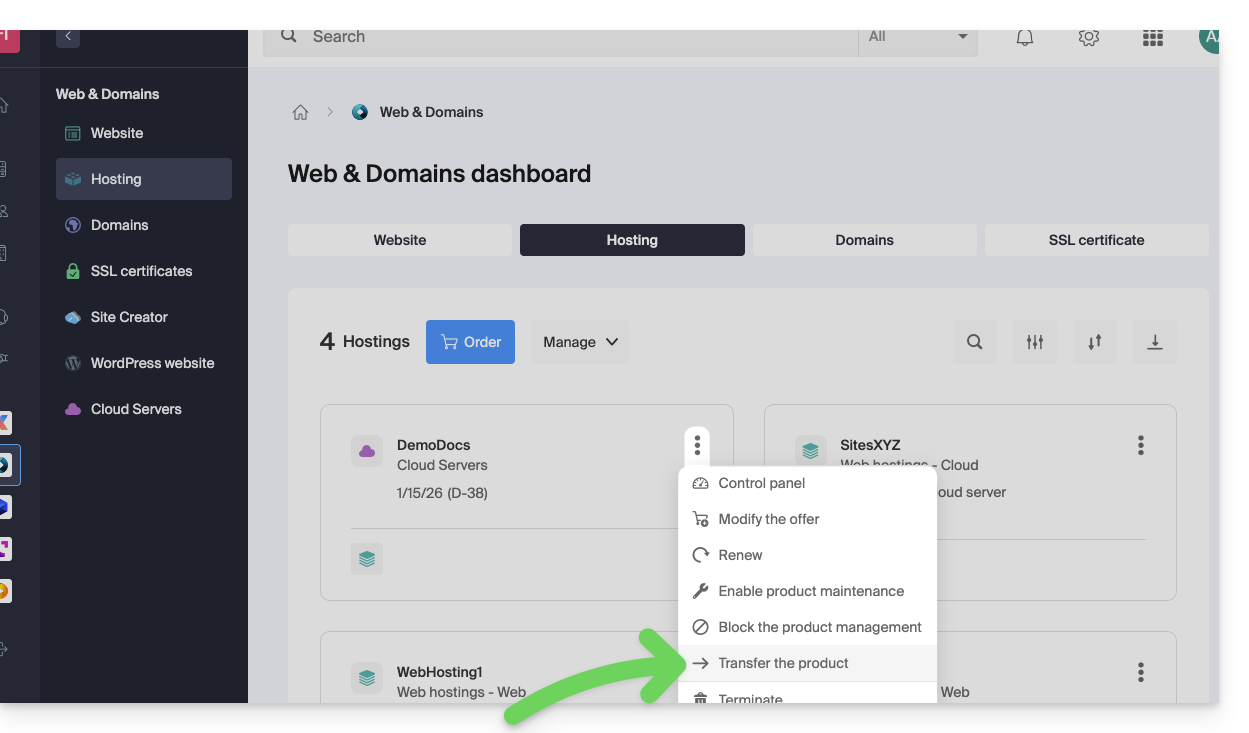
Refer to this other guide regarding Jelastic Cloud.
Receive the product
Once a product transfer is initiated by a user…
1. Be on the Organization that should receive the product
- Click here to log in to the Manager on the Organization that should receive the product(s).
- The user specified when logging in to the Infomaniak account must have administrative rights.
- If necessary, you can create a new Organization to receive products.
2. Execute the obtained link
- Click on the link obtained in the first step above.
- You can also simply paste it into a browser while logged in to the appropriate Infomaniak account.
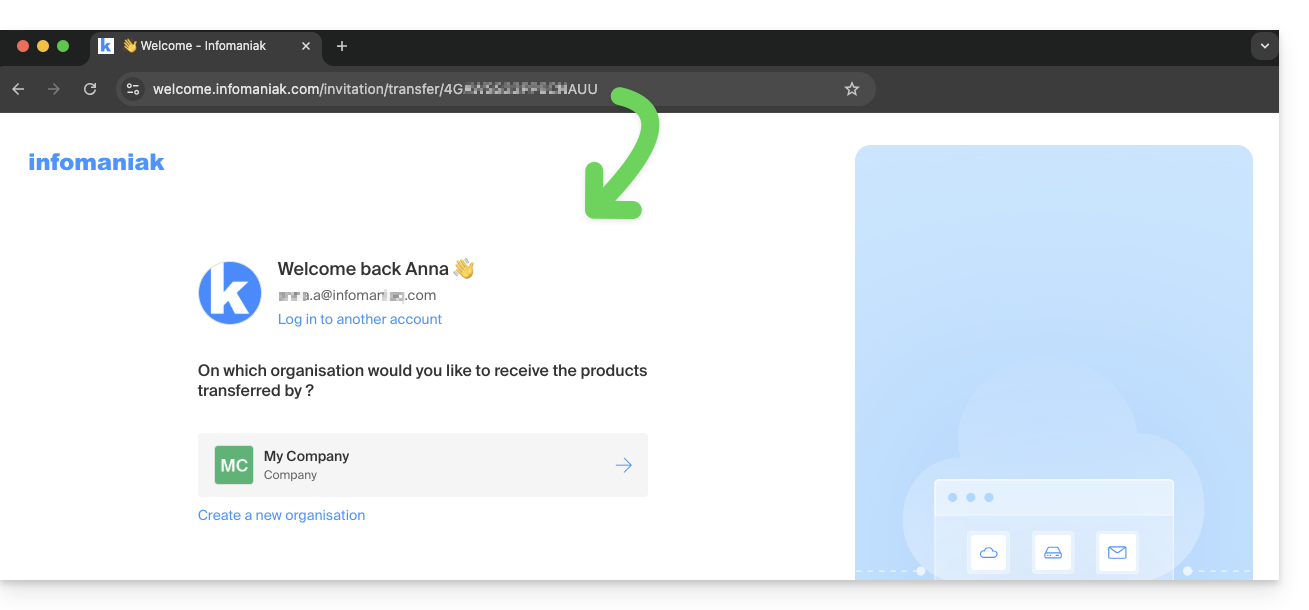
3. Validate the product transfer
- If necessary, choose the destination Organization using the drop-down menu.
- Read and accept the general conditions.
- Click the Receive the product button (if the button is not clickable, make sure you have selected the Organization).
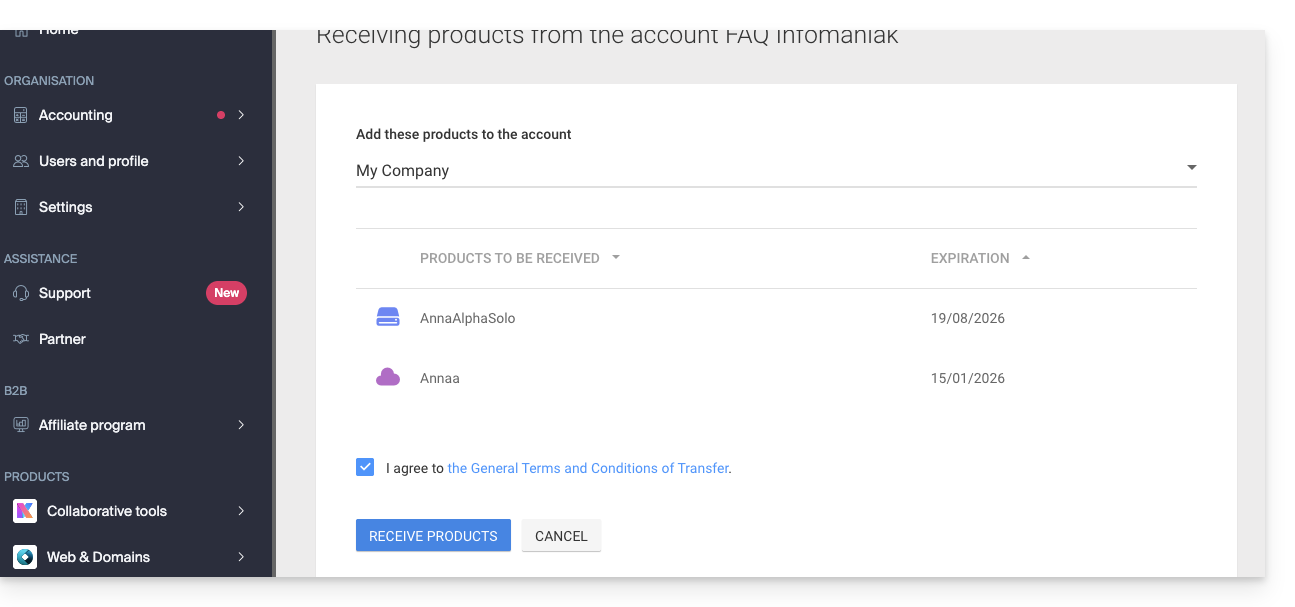
Find the ongoing or completed transfers at any time from the bottom icon on the left sidebar of the Infomaniak Manager: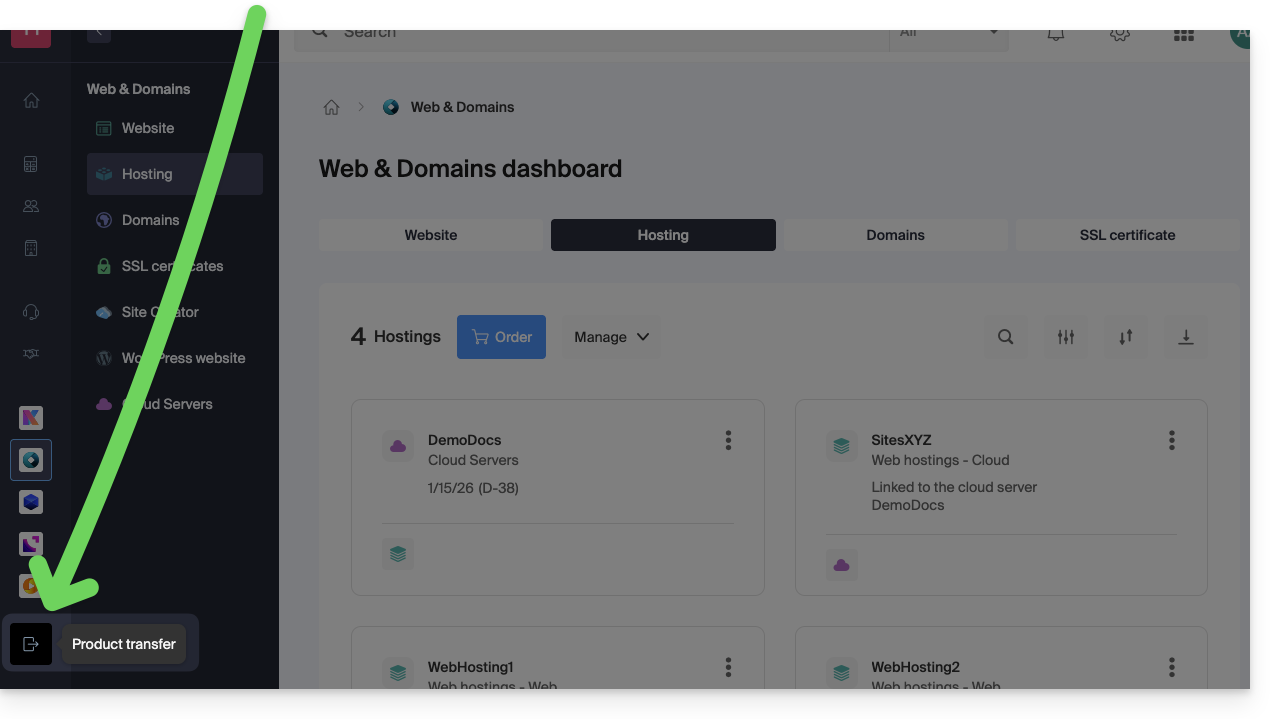
This guide describes the technical requirements to use an IP camera (RTSP or RTMP) with the Streaming video platform.
Introduction
There are two types of compatible cameras:
- RTSP cameras: Infomaniak servers connect to the camera to pull the stream via the RTSP protocol
- RTMP cameras: the camera acts as an encoder and pushes the stream to Infomaniak's distribution servers
1. RTSP Camera (PULL mode)
Some cameras can directly stream a video and audio feed over the Internet without a dedicated encoder. In this case, however, it is necessary to ensure that your device meets the following requirements:
- support for the RTSP protocol
- support for the H264 video codec (MPEG4 is not sufficient)
- The device must be reachable from the Internet on port 554 (other ports are not accepted)
- The camera's access address must work in a video player (VLC, MPlayer, etc.) and this, including from a network external to that of the camera
2. RTMP Camera (PUSH mode)
Any camera capable of sending an H264 video and AAC audio stream to a server via the RTMP protocol should be compatible with the Streaming vidéo platform.
This guide allows you to quickly use the essential functions of the Streaming vidéo Infomaniak.
Set up a stream
The transmission of a stream to Infomaniak servers can be done either…
- … via a video encoder (or a camera acting as an encoder) that will push the stream to the servers; to offer multiple stream qualities and improve your users' experience, you have the option to enable multi-bitrate
- … via an IP camera, or an external source from which the servers will pull the stream
Create a Player to offer the stream to viewers
- Click here to access the management of your product on the Infomaniak Manager (need help?).
- Click directly on the name assigned to the relevant product.
- Click on Integration in the left sidebar.
- Click on Players in the left sidebar.
- Click on the blue button to add a player.
Record your live streams in a scheduled or automatic manner
Refer to this guide to learn how to archive or record your broadcasts.
Restrict broadcasting
- Secure a video stream by IP restriction
- Secure a video stream by GeoIP restriction
- Secure a video stream with a unique key
- Secure a video stream by domain restriction
To learn more…
- Embed a watermark/logo on a live video stream
- Why is there a delay between my source and the availability of a stream?
- Which cameras are compatible with the Infomaniak platform?
A question or feedback?
- In case of a problem, please consult the knowledge base before contacting support.
- Click here to share a review or suggestion about an Infomaniak product.
This guide concerns the broadcasting of video streams directly from mobile cameras on the service of Streaming vidéo Infomaniak.
Live streaming...
... with encoder
The classic operation of Streaming vidéo involves using an encoder to transform the stream coming from a source such as a camera or webcam.
Example with a GoPro: to broadcast what it films live (setting up a live webcam, for example), you can connect it via its HDMI cable to your capture card (such as an AVerMedia or Blackmagic Design card) which has an HDMI input.
Use software like OBS Studio and configure it to recognize the video source from the capture card and encode the video stream and transmit it to the streaming server (Infomaniak).
… without an encoder
With suitable cameras that natively output h.264, there is no longer a need for an encoder; you can connect your camera directly to the Streaming video system. The camera directly encodes the video stream in a compatible format (H.264) and transmits it via RTSP (Real-Time Streaming Protocol) directly to the streaming server. However, this system only works with a limited list of cameras (see below). Certain modules, such as video recording, are not compatible with this mode of operation.
To access the configuration:
- Click here to access the management of your product on the Infomaniak Manager (need help?).
- Click directly on the name assigned to the relevant product.
- Click the button to configure the encoder:

- Click on the IP CAM / EXTERNAL source

Read the prerequisites on the configuration page before continuing with the setup. Also, refer to this other guide.
Compatible Cameras
- Axis
- Series M: M10X, M11X, M30X, M31X, M7001
- Series P: P13X, P33X, P55X
- Series Q: Q1755, Q60X, Q16, Q17, Q19, Q35, Q61, Q62
- Sony
- SNC-CH110, SNC-DH110, SNC-CH210, SNC-DH210
- SNC-CH120, SNC-DH120, SNC-CH140, SNC-DH140
- SNC-CH160, SNC-DH160, SNC-CH180, SNC-DH180
- SNC-CH220, SNC-DH220, SNC-CH240, SNC-DH240
- SNC-CH260, SNC-DH260, SNC-CH280, SNC-DH280
- SNC-RH124, SNC-RH164
- Series SNC-EB600, SNC-EM600, SNC-EM602RC, SNC-VM600, SNC-VM601, SNC-VB600, SNC-VB630, SNC-WR600, SNC-WR602
- Hikvision
- DS-2CD2020, DS-2CD2032, DS-2CD2042, DS-2CD2120, DS-2CD2132, DS-2CD2142, DS-2CD2152
- Dahua
- IPC-HFW1120S, IPC-HFW1220S, IPC-HFW1320S, IPC-HFW1400S, IPC-HDW1120S, IPC-HDW1220S, IPC-HDW1320S
- Bosch
- NDE-3502, NDE-4502, NDE-5502, NIN-50022, NIN-70122
- Panasonic
- WV-S1110, WV-S1131, WV-S2110, WV-S2131, WV-S3110, WV-S3131
- Samsung Hanwha Techwin
- QND-6010R, QND-6020R, QND-6030R, QND-7010R, QND-7020R, QND-7030R
This guide helps you configure your encoder with the Streaming video service.
Preamble
- The structure of this guide is organized based on the encoding quality chosen for your stream:

- The URL-based authentication system offered by Infomaniak differs from the default authentication offered by some encoders.
- This information is provided for reference only, and the configuration of your encoder may vary depending on your device, your software, and the options of your product.
Encoder configuration required
Here is how to access the configuration information required by your encoder:
- Click here to access the management of your product on the Infomaniak Manager (need help?).
- Click on the action menu ⋮ to the right of the relevant item in the displayed table.
- Click on Configure the encoder:

- Follow the instructions tailored to your situation.
1. Automatic management of multi-bitrate by Infomaniak
The following information applies if you have chosen to let Infomaniak automatically manage the quality of your stream. In this case, the following configuration information is available:
In this example, the stream is named "F.A.Q." and its authentication key is "3bmPvLqc" :
- Server address:
rtmp://faq.vprimary.infomaniak.com/livecast?key=3bmPvLqc - Stream name:
faq
1.1 Source Quality Configuration
The stream qualities generated by Infomaniak will depend on the quality of your source (bitrate). Here is an indicative list of the qualities that could be generated at the time of connecting your encoder:
- 1080p with a bitrate of 3 Mbps
- 720p with a bitrate of 1.8 Mbps
- 480p with a bitrate of 0.8 Mbps
- 360p with a bitrate of 0.5 Mbps
- 240p with a bitrate of 0.3 Mbps*
* 240p will only be offered if your source bitrate is less than 0.8 Mbps.
It is ideally recommended to set a source of 1080p with a bitrate of 3.2 Mbps to generate all available qualities. If the bitrate of your source is limited to 1 Mbps, only the following resolutions will be generated: 480p, 360p and 240p.
Important: ensure that the bitrate control is set to CBR (constant bitrate) on your encoder. The ABR (adaptive bitrate) mode can indeed distort the detection of your source bitrate.
1.2 Your encoder requires a connection address and a stream ID
If your encoder requires a connection address and a stream ID, simply enter the server address and stream ID in your encoder.
In this example, the following information would be required:
- Server address:
rtmp://faq.vprimary.infomaniak.com/livecast?key=3bmPvLqc - Stream ID:
faq
1.3 Your encoder requires only a URL
If your encoder requires only a URL, you need to combine the server address and the connection identifier; in this case, the URL would be the following:
rtmp://faq.vprimary.infomaniak.com/livecast?key=3bmPvLqc/faq
1.4 Your encoder offers advanced configuration
If your encoder offers a wide range of parameters, follow the instructions below, which are always based on the same example:
- RTMP Server Address:
faq.vprimary.infomaniak.com - RTMP server port:
1935 - RTMP Username: leave this field empty (authentication is done by key with a key on the stream identifier)
- RTMP Password: leave this field empty (authentication is done by key with a key on the stream identifier)
- RTMP Application Name:
livecast?key=3bmPvLqc - RTMP Stream Name:
faq
2. Manual management of multi-bitrate
The following information is relevant if you have decided to manually manage the quality of your stream. If you are using the Cloud Transcoding option, refer to the 3. Single bitrate section below.
In this case, you will find a table containing the different qualities (bitrate/resolutions) that you defined during the configuration of your encoder:
In this example, the stream is named "faq" and its authentication key is "3bmPvLqc".
2.1 Your encoder requires a connection address and a stream ID
If your encoder requires a connection address and a stream ID, simply enter the server address and ID for each stream in your encoder.
2.2 Your encoder requires a URL per stream
If your encoder requires specific configurations per URL, you need to group the server address and the connection identifier for each bitrate. In this case, the URLs would be as follows:
- Bitrate 2000000 : rtmp://faq.vprimary.infomaniak.com/livecast?key=3bmPvLqc/faq
- Bitrate 1000000 : rtmp://faq.vprimary.infomaniak.com/livecast?key=3bmPvLqc/faq_1
- Bitrate 500000 : rtmp://faq.vprimary.infomaniak.com/livecast?key=3bmPvLqc/faq_2
- Bitrate 250000 : rtmp://faq.vprimary.infomaniak.com/livecast?key=3bmPvLqc/faq_3
3. Single bitrate (one quality)
Take note of the instructions provided in point 1. Automatic management of multi-bitrate by Infomaniak ignoring point 1.1.
This guide explains how to insert an image, a logo, a watermark, on your video streams to enhance your brand image and protect your content from copying or potential misuse.
Add the image to the stream
You have the possibility to add an image that will appear on your video stream:
- either from the configuration of a Player (free)...
- The logo is superimposed on the video and will not be visible if the stream is embedded outside of the Player.
- or by embedding the logo via transcoding (paid option)…
- The logo is embedded in the video and will be visible in all cases; this requires the complete re-encoding of the stream(s) by a transcoding server, which explains the cost of this method.
In both cases, it is possible to customize the following parameters:
- Position of the logo (in one of the four corners of the player, spacing from the edge, etc.).
- Size of the logo (for example, a logo at 50% will be twice as small):
- It is recommended to use the native size to optimize the loading and quality of the rendering.
- In the case of video transcoding, the size of the logo is calculated based on the source video (or maximum quality); the logo will be automatically resized if lower qualities are present to maintain an identical ratio.
- Opacity of the logo.
1. Overlay a logo via the Player (free)
- Click here to access the management of your product on the Manager Infomaniak (need help?).
- Click directly on the name assigned to the relevant product.
- Click on Integration in the left sidebar.
- Click on Players in the left sidebar.
- Click on the name of the Player to customize.
- Click on the tab (or dropdown menu) Appearance.
- Add the desired logo in
png,jpgorgif(non-animated) format:
2. Enable the watermark option (paid feature)
- Click here to access the management of your product on the Manager Infomaniak (need help?).
- Click directly on the name assigned to the relevant product.
- Click on Settings in the left sidebar.
- Click on Options from the left sidebar.
- Enable the Watermark option.
- Add the desired logo in png, jpg or gif (non-animated) format:

It is quite possible to create a Streaming Live for a few hours during one-off events.
Even though the minimum billing duration is per month, you can use all of your bandwidth in a month or in a single day.
Features of the offers
This guide explains how to broadcast a live video with multiple audio tracks via the Infomaniak Video Streaming service. It does not cover VOD or an audio streaming service (used only as a complement if you choose approach A below).
Preamble
- A live Video Streaming stream does not offer selectable multi-audio tracks in a single player.
- Two possible topologies:
- Approach A — 1 video stream + 1..N separate audio players (language selection on the page side).
- Approach B — N Video Streaming streams broadcasting the same image with different audio (one player per language).
Method to obtain a multilingual live stream
Approach A — 1 video player + separate audio players
- General idea: you send a single live video to Infomaniak and, on your page, you add audio players (one per language). The user mutes the video player's sound and activates the audio player in the desired language.
- Simple on the sending side: one video stream to send to Infomaniak.
- Less simple on the page side: the user must juggle between the video player's sound (muted) and the audio player (activated). A slight delay between the image and the audio may exist.
To do this:
- Retrieve the streaming address and key in the Infomaniak Manager (this is the "ingest"). Copy them into your streaming software.
- Start your live video from the software: Infomaniak receives the image and publishes a video player (player) that you can integrate on your site.
- On your web page, add the audio players (one per language). They are separate from the "Video Streaming" product: you place them right next to the video player.
- Provide a small language selection interface (FR/EN/ES buttons...). When the user selects a language, mute the video player and activate the corresponding audio player.
- Reduce the delay (if it is important to you): avoid "rewind" options and unnecessary processing that add delay; keep stable settings in your software.
Ingest is the step of connection : Infomaniak provides you with a receiving address and a key ; you paste them into your streaming software (e.g. OBS or a hardware encoder). When you click on « Start », your video is sent to this address: Infomaniak receives it and can then stream it to viewers; without this address and this key, nothing happens on the platform.
Approach B — multiple video players (one per language)
- General idea: you create multiple live videos at Infomaniak, all with the same image, but each with a different language. On your page, the user chooses their language and you display the corresponding video player.
- More fluid for the user: they simply choose a player « in their language ».
- More demanding for you: multiple lives to create/maintain and more data to send in parallel.
To do this:
- Create a live per language in the Infomaniak Manager. For each live, note the address and the streaming key (the « ingest »).
- In your streaming software, duplicate the video output and assign the correct audio track (FR, EN, etc.) to each copy. Send each copy to the address/key of the corresponding live.
- Let Infomaniak handle the playback qualities (resolution/quality adapted to the viewer's connection). If you prefer to handle everything yourself, it's possible but more advanced; stay simple if you're a beginner.
- Integrate a language selector on your page: when the user chooses « FR », you display the FR live player; if they choose « EN », you display the EN live player, etc.
- Check your upload connection: the more languages, the more data you send at the same time. Do a load test before the big day.
Each language has its own live, therefore its own receiving address and its key ; you must send the same image multiple times (once per language) to Infomaniak: it's always the connection step that allows the platform to receive each version.
This guide covers multi-bitrate or transcoding, which allows you to stream a video stream in the best possible quality based on your viewers' internet connection.
Preamble
- Without the multi-bitrate or transcoding feature, your stream is only broadcast in one quality, and viewers with a poor internet connection may not be able to watch your stream.
Local transcoding vs. Cloud transcoding
There are two ways to offer this feature to your visitors: local transcoding or cloud transcoding.
Advantages and disadvantages
Let Infomaniak handle the transcoding
The entire process is automatic: Infomaniak configures and transcodes the necessary qualities, and your viewers are guaranteed to be able to follow your broadcasts in the best possible conditions, regardless of their internet connection speed.
- Only one maximum quality stream will be sent from your side.
- A software encoder is sufficient, although it is recommended to have a hardware encoder for better reliability and performance.
Manually manage transcoding locally
The entire process is manual: you must configure the qualities and their number, as well as have the required network and hardware configuration to ensure transcoding and data transmission:
- An encoder is required for transcoding (Infomaniak offers them for sale if necessary).
- The encoder (or the server dedicated to this task) must be powerful enough to simultaneously transcode your stream in different qualities. Otherwise, the stream will be cut and unstable for your viewers.
- A good internet connection is required to simultaneously send the stream in different qualities.
This guide explains how to broadcast an online meeting kMeet in a separate stream accessible via a unique URL thanks to Infomaniak Video Streaming.
⚠ Available with:
| kSuite | |
| Business | |
| Enterprise | |
Preamble
- Broadcasting a conference-type meeting in a Video Streaming stream rather than within the kMeet application has several advantages:
- Large-scale public broadcasting without having to restrict access to an audience limited to invited people.
- Attract a wider audience, such as conferences, webinars or live events where hundreds or thousands of viewers can follow the event without joining a private call.
- Allows reaching an unlimited number of viewers.
- No need to manage access for each participant, the stream is simply viewable via a link.
- A simple web browser is sufficient to access the streaming stream.
- Passive access: viewers are not forced to actively participate or interact; they can simply watch the event without registering or logging in, which is better suited for large events.
- No vocal interruptions or disruptions related to microphone management; this allows for a more fluid stream focused on the speaker.
- Higher broadcast resolution when kMeet can be limited by bandwidth constraints and lower video quality to avoid network overload.
Create the Video Streaming share link
Prerequisites
- You must be a moderator of kMeet to be able to create a live broadcast link but it is not necessary to own an Infomaniak Video Streaming offer.
Next:
- Start kMeet via ksuite.infomaniak.com/kmeet or from one of the applications for computer or mobile devices.
- Once in the meeting, click on the action menu ○○○ in the kMeet toolbar.
- Choose to Start live broadcast:

- Click the button to Start:

- Wait for the Video Streaming stream to be created:

- In the same place, once the stream link is displayed, click on the icon on the right to copy the URL corresponding to the live stream; paste the URL in a message to the participants or to anyone who needs to attend the live broadcast.
- A symbol displayed on kMeet as well as an audible alert indicates the start of the broadcast via Video Streaming:

The stream is broadcast continuously for a maximum of 24 hours, and will no longer be accessible as soon as the kMeet meeting is stopped.
This guide concerns the Infomaniak Video Streaming platform, which offers two possibilities to retrieve video streams for broadcasting:
- The PUSH mode: you push the stream to the Infomaniak platform…
- The PULL mode: you provide a source URL from which Infomaniak will retrieve the stream; this method allows you to broadcast an existing stream via Infomaniak.
IP Camera (PUSH mode)
The most common use case involves IP cameras, accessible from a URL or an IP address.
For optimal operation:
- Your equipment must support the RTSP protocol and the H264 video codec (do not rely on the MPEG4 indication).
- Your equipment must be publicly reachable from the Internet on port 554 (any other port will be refused).
- The RTSP address must work in a video player (VLC, mplayer, ...).
- The RTSP address must be retrievable via the administration interface of your equipment.
External Source (PULL mode)
It is also possible to retrieve the stream from an external source, which allows, for example, to process an existing stream by adding a watermark and to use Infomaniak's broadcasting servers to reach a wide audience.
Currently, the following stream formats are supported:
- RTP
- RTSP
- RTMP
This guide explains how to live stream a list of videos from the VOD service using the Video Streaming product.
Preamble
- This feature allows you to use the VOD service to create a video playlist and then use the Video Streaming service to broadcast it live, for example as part of a music video channel, teleshopping, documentaries, etc.
- It is possible to insert advertisements between each video, manually or via the use of VAST tags.
- The playlist will loop indefinitely until the user stops it.
Broadcast a VOD playlist in live streaming
Prerequisites
- Have a VOD service (at least the free VOD space with the Video Streaming service).
- Have a Video Streaming service in the same Organization and managed by the same account.
To create the playlist, import some videos:
- Click here to access the management of your product on the Infomaniak Manager (need help?).
- Click directly on the name assigned to the product in question.
- Click the Select button (in the Quick Import section).
Once the videos are imported:
- Click on Media in the left sidebar menu.
- Click on Playlists / WebTV in the left sidebar menu.
- Click the button to add a new playlist.
- Name the playlist and determine if it should be automatic (linked to a folder) or manual.
- Choose the folder or specific videos to use to create the playlist.
- Click the Create Live button:

- Choose the stream of the Video Streaming service that will broadcast the playlist and set your preferences:

Some usage examples
Broadcasting a playlist can serve as a fallback solution as soon as a live stream is interrupted (voluntarily or involuntarily) and in this case take over the air. As soon as the live encoder pushes a stream, it takes control of the playlist. This allows you to broadcast alternative content if there is a problem with the live stream or if the user only broadcasts real live content in the evening for example, they can automate the broadcasting of content from playlists for the rest of the day.
It is also possible to schedule the broadcasting of a playlist from the Video Streaming scheduling tool. Thus, you can choose to broadcast unique or different playlists in advance, or on a recurring basis. The encoder broadcasting live will be automatically disconnected and this for the entire duration of the playlist broadcast; once the time slot is over, the encoder will reconnect and its content will be broadcast.
A VOD playlist can be created and then edited manually (by retrieving the video that must complete the list) or be dynamic if automatically constituted by a batch of videos located in a specific folder and fed over time. In both cases, stop then restart the live broadcast to take into account any new video added to the playlist - note that this will no longer be necessary during a future update of the tool.
This guide explains how to restrict access to Infomaniak Video Streaming streams using a unique key (hash).
Preamble
- This method offers the highest level of protection and allows you, for example, to restrict your broadcasts to a members-only area requiring authentication.
- The way to generate this code is specific to each site, so it will be necessary to implement the required PHP functions and adapt the integration code of your player accordingly.
Restrict access to broadcasts by unique key (hash)
To do this:
- Click here to access the management of your product on the Infomaniak Manager (need help?).
- Click directly on the name assigned to the relevant product.
- Click on Settings in the left sidebar.
- Click on Restrictions in the left sidebar.
- Click on the Unique hash restriction tab:

How restrictions work
This method requires retrieving information related to the configuration of your stream and the user who is connecting.
First, you need to set a password (a key) in the Infomaniak Manager. As soon as this key is added, connected viewers and those attempting to watch your stream will be instantly blocked (refer to this other guide to customize the replacement image offered to blocked viewers).
Here is the procedure to follow to authorize access to your stream:
- Design an authentication system of your own (e.g. a member space).
- Take the password configured above on the Manager.
- Retrieve the IP of users via
$_SERVER["REMOTE_ADDR"]for example. - Get the identifier of the stream to target.
- Retrieve the current date and time (without minutes and seconds).
These elements will then be hashed by the code provided in the Manager to generate a unique token specific to each user that will be transmitted to the stream at the time of loading. The streaming platform will then check the validity of the hash to authorize or reject the connection.
Important notes
- To ensure the security of access to the stream, the validity of each token is time-limited.
- It is important to disable caching on the pages that allow access to the stream; indeed, if the token generation is cached, other users will attempt to authenticate with someone else's hash, which will cause them to be rejected even if they are authorized to consume the stream.
This guide explains how to do a 360° live stream with Infomaniak's video streaming service.
Prerequisites
- Have a 360 camera compatible with one of the following formats:
- equirectangular 360 monoscopic (2D)
- 360° equirectangular stereoscopic (3D) side by side (left/right separation)
- equirectangular 360 stereoscopic (3D) top/bottom (top/bottom separation)
- Your encoder or your camera must also be able to send a stream via an RTMP connection (learn more).
- Finally, note that a 360° video stream requires a source with a high bitrate and a bitrate control set to CBR mode; the bitrate will depend on the type of content and data consumption, which will also be higher than with a standard stream.
Create a 360° player
Broadcasting a 360° live stream requires a 360° player. This option is free and can be activated quickly:
- Click here to access the management of your product on the Infomaniak Manager (need help?).
- Click directly on the name assigned to the relevant product.
- Click on Integration then on Players in the left sidebar to create or edit an existing player.
- Check the Player 360 box and configure the projection (360 format):

- Click the Save button.
- All content broadcasted by this player (whether it is in 360° format or not) will now be interpreted as 360°.
This guide explains how to record or archive all of your Video Streaming broadcasts, which can be useful for creating TV replays or reviewing videos recorded by surveillance cameras, for example.
Manage automatic recording of live broadcasts
To activate this option:
- Click here to access the management of your product on the Infomaniak Manager (need help?).
- Click directly on the name assigned to the product concerned.
- Activate the recording of live broadcasts by the toggle switch from the stream dashboard:

Once this feature is activated, the stream will be automatically and permanently recorded from the moment it is sent to (or pulled by) the Infomaniak platform.
Be mindful of your FTP space, which could quickly become saturated. If necessary, you also have the option to manually schedule recordings from the scheduling tool.
Operation of automatic recordings
Once this option is activated, an mp4 file will be automatically generated after each broadcast, which will be transferred to the FTP or VOD space configured by you.
Important details:
- A broadcast is defined as the time between connection and disconnection up to the video encoder.
- Recording quality: in the case of a multi-bitrate stream, the maximum source quality will be preserved.
- File size limitation: in the case of continuous broadcasting, you have the option to define the maximum duration of each mp4 file; this option allows you to avoid generating files that are too large and to ensure the recording of your archives to the FTP or VOD space of your choice (and once the duration is reached, the recording is automatically stopped, then sent by FTP and a new recording is started).
Customization of recording names
To allow you to easily identify and classify your archives, the name of the recordings can be customized dynamically using parameters specified between curly braces.
Example:
template_{stream_id}_{date|format:YYYY-MM-dd_hh:mm:ss}_{fragment_id|from:1|prefix:fragment_(|suffix:)}.{extension}stream_id= represents the stream identifier in the form of a string.date|format: ISO 8601 = date of the recording day.time|format: ISO 8601 = time of the recording.datetime|format: ISO 8601 = date and time of the recording.fragment_id|from:number|prefix:string|suffix:string: = fragment number in case a recording is split with the possibility of prefixing and/or suffixing it.- Each fragment will be incremented, "
from" allowing to indicate what will be the first reference fragment.
- Each fragment will be incremented, "
extension= final extension of the file.
These parameters and their options are optional and their order is completely free. They can be used as many times as desired. If you provide the same option multiple times, only the last one will be taken into account. Any unrecognized option will simply be ignored.
Example 1
Situation: you have two daily schedules, the first starts at 10:00 and the second at 20:05. By configuring the file naming in this way template_{date|format:hh:mm:ss} you will obtain the following file names:
For the day of December 5, 2019:
- The first recording at 10:00 will be called:
template-10:00:00.mp4 - The second recording at 20:05 will be called:
template-20:05:00.mp4
For the day of December 6, 2019:
- The first recording at 10:00 will be called:
template-10:00:00.mp4
The recording from the previous day with the same name will be overwritten and replaced by this one. - The second recording at 20:05 will be called:
template-20:05:00.mp4
The recording from the previous day with the same name will be overwritten and replaced by this one. - etc.
This logic can be particularly useful for having a loop recording system, for example for video surveillance. The user will retrieve the video only if needed and this avoids archiving a potentially infinite number of videos at the risk of saturating the FTP space.
Example 2
Situation: this time you have a perpetual recording, 24/7, with a limitation of the duration of the files set to 360 minutes. By configuring the file naming in this way template_{date|format:YYYY-MM-dd}_{fragment_id|from:1|prefix:fragment_(|suffix:)}.{extension} you will obtain the following file names:
- The first file of the day at 00:00 will be called:
template_2019-02-05.mp4 - The second file of the day at 06:00 will be called:
template_2019-02-05_fragment(1).mp4 - The third file of the day at 12:00 will be called:
template_2019-02-05_fragment(2).mp4 - The fourth file of the day at 18:00 will be called:
template_2019-02-05_fragment(3).mp4
By configuring the file naming in this way template_{date|format:YYYY-MM-dd}_{fragment_id|from:0|prefix:fragment_(|suffix:)}.{extension} you will get the following names:
- The first file of the day at 00:00 will be named:
template_2019-02-05_fragment(0).mp4 - The second file of the day at 06:00 will be called:
template_2019-02-05_fragment(1).mp4 - The third file of the day at 12:00 will be called:
template_2019-02-05_fragment(2).mp4 - The fourth file of the day at 18:00 will be called:
template_2019-02-05_fragment(3).mp4
This guide explains how to activate and use the Timeshift (also called DVR) function on your live video broadcasts. This feature allows your viewers to rewind if they missed the start of your live broadcast.
Activate the Timeshift (DVR) function
To access the video streaming service:
- Click here to access the management of your product on the Infomaniak Manager (need help?).
- Click directly on the name assigned to the product in question.
- Click on Configure under Timeshift from the dashboard:

- Activate Timeshift.
- Set the duration during which your viewers will be able to rewind (max. 240 min.).
- Click the Activate button:

Customize the Timeshift function
It is possible to activate this option via the scheduling tool for a specific time slot and thus limit this possibility to certain programs. The parameters defined in the scheduling tool will override the default state set from the dashboard.
To understand this better, imagine a TV broadcasting a football match from 10 am to 12 pm.
1. The TV wants to activate Timeshift only during the match
With this configuration, viewers who join the live broadcast at 11:59 am will be able to rewind to the start of the match at 10 am, but they will not be able to rewind to the shows that preceded the match before 10 am. For the record, the maximum duration of the Timeshift is 240 min. (4 hours).
2. The TV wants to activate a 20-minute Timeshift only during the match
With this configuration, viewers who join the live broadcast at 11:30 am will be able to rewind the previous 20 minutes, but they will not be able to rewind to the start of the match; only the last 20 sliding minutes will be accessible for the entire duration of the match.
3. The TV wants to deactivate Timeshift during the match
With this configuration, viewers will not be able to rewind parts of the match. They will only be able to see the shows that precede the match if the Timeshift function has been activated by default from the stream dashboard.
In summary, there are therefore 2 use cases
- Activate Timeshift permanently, except for special events.
- Disable Timeshift permanently, except for specific events.
The default status is managed from the stream dashboard and exceptions from the scheduling tool.
Learn more about how it works
If you have set a one-hour Timeshift and just activated it, the return time will gradually increase to the chosen duration from the moment of activation.
If geographical restrictions are defined with a specific time range, these will always be respected. In the case where a TV with a 4-hour Timeshift reserves its sports program for Swiss visitors from 10 AM to 12 PM, an Italian viewer who connects to the stream at 1 PM can only re-watch the shows from 9 AM to 10 AM.
This guide explains how to restrict access to Infomaniak Video Streaming streams to your own site only.
This protection does not prevent the integration of a stream via an HTML iframe tag. Use the unique hash protection for a higher level of security.
Restrict access to broadcasts to a domain
To do this:
- Click here to access the management of your product on the Infomaniak Manager (need help?).
- Click directly on the name assigned to the product in question.
- Click on Settings in the left sidebar menu.
- Click on Restrictions in the left sidebar menu.
- Click on the Domain Restriction tab:

- Define the site(s) that should be specifically authorized to load the stream.
- Click the Save button.
Refer to this other guide to customize the replacement image offered to blocked viewers.
This guide explains how to display a countdown before the next live broadcast or during a scheduled interruption.
Scheduling interruption feature
To access the scheduling calendar:
- Click here to access your product management on the Infomaniak Manager (need help?).
- Click directly on the name assigned to the relevant product.
- Click on Scheduling in the left sidebar.
- Click on Scheduling Tool in the left sidebar:

- Click on the desired date.
For example, this configuration on the calendar to interrupt a live program…
… and this configuration for the image and text selection…
… will display this result from 3 PM, with a second-by-second countdown of 2 hours visible on the Player of your TV stream:
Once scheduled, the countdown works in correlation with stream cuts if you set one (or several in a row, thus managing the overlap). Note: it takes 2 minutes for a scheduled interruption to be reflected on the countdown.
This guide explains how to customize a Player for Streaming vidéo Infomaniak so that an image of your choice is offered to viewers, especially in case of stream restrictions.
Preamble
- A video stream can be restricted:
- Scheduled interruption of the broadcast (possibility to display a countdown before the broadcast resumes)
- Geographical restrictions or other restrictions (IP blocking, domain(s), token, etc.)
Customize the Video Streaming Player
To do this:
- Click here to access the management of your product on the Infomaniak Manager (need help?).
- Click directly on the name assigned to the relevant product.
- Click on Integration in the left sidebar.
- Click on Players in the left sidebar.
- Click on the name of the Player to customize.
- Click on the tab (or dropdown menu) Thumbnails:
- Customize the desired thumbnails:


